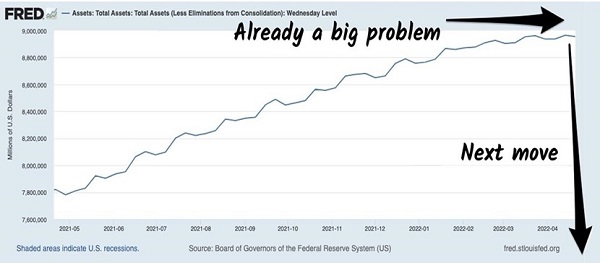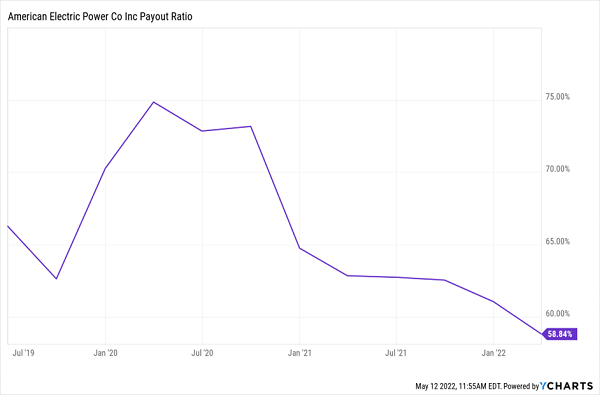These days, we contrarian income seekers are following a simple rule: “trade lightly.” Truth is, we saw this mess coming. It’s why we started lightening up our positions back in November.
In so doing, we’ve locked in some very nice returns, like 90% on chemical maker Chemours (NYSE:CC), 44% on blue-chip-focused closed-end fund (CEF) Gabelli Dividend & Income Closed Fund (NYSE:GDV), and 98% on the PIMCO Dynamic Income Fund (NYSE:PDI) (formerly PCI).
We didn’t sell any of these dividend payers because something was wrong with them—far from it!
They’d simply ridden Jay Powell’s cheap-money wave as far as they could. Now that wave is flowing in reverse, with rates rising and the Fed shedding bonds from its balance sheet at a rate of $95 billion a month.

All of this has caused the stock market to, ahem, correct.
Someday soon we’ll reload. In the meantime, we’re collecting rich dividends from our current holdings, making our shopping list, and getting set to pounce on the next big buying opportunity—because it’s coming.
But what if you can’t wait?
I get it—and I hear it regularly from readers. And indeed, there are some “safety-first” dividends out there that profit from inflation and boast low volatility—a godsend today and for 2023, when a recession is likely in the cards.
We’ll look at two good examples of these types of stocks below. (Note that these aren’t official CIR recommendations, but they may work for you, depending on your portfolio makeup and situation.)
First, let’s talk about what a stock needs to thrive in this inflation-and-recession spooked market.
Relative Strength, Big Payouts And Pricing Power: Our “Dividend Trifecta”
When hunting for reliable dividends, we primarily want stocks that have held up better than their peers in this dumpster fire. It only makes sense—if they’ve stayed strong now, they’re likely to keep doing so. And when the market (inevitably) turns, they’ll have a sturdy base from which to jump.
Note that we’re not looking for bargain P/E ratios here. Just stocks with resilience that are backed by strong societal trends.
Finally, we want companies with the pricing power to pass their rising costs off to consumers, letting them not only survive inflation, but thrive during it.
Let’s get started with …
1. A Canadian “Battleship” Dividend That Charges Whatever It Wants
BCE (NYSE:BCE) is a Canadian telecom provider that has pricing power in spades! It, along with Telus Corp. (NYSE:TU) and Rogers Communications (NYSE:RCI), essentially form an oligopoly, with an iron grip on Canada’s telecommunications market. That’s why Canadians pay some of the highest cell phone rates in the world.
Pricing power? Check!
Now let’s talk relative strength. As you can see, BCE, which also controls major Canadian television network CTV and owns the Toronto Maple Leafs and Raptors, is holding up just fine in the mess we’ve been facing this year, thumping American cousin Verizon Communications (NYSE:VZ) and staying in the green.
BCE Dusts US Competition

Throw in a nice 5.5% dividend and a record of strong and steady payout growth (the dividend is up 70% in the last decade, in Canadian dollars), and you have all the makings of a “battleship” dividend payer.
It’s not surprising that this one is a mainstay in Canadian investment portfolios, but we don’t have to miss out stateside: BCE trades on the NYSE, so it’s easy to buy.
2. An “All-Weather” 3.1% Payout That’s Growing Fast
Electric utilities are another go-to at times like these, and American Electric Power (NASDAQ:AEP) is one of the biggest, with 5.5 million customers in 11 states.
Utilities are paying higher prices for coal and natural gas these days, but AEP is smartly offsetting those with a rapid shift to renewables, with plans to produce 50% of its power from clean sources by 2030.
The best thing about utilities, of course, is that they hold up in all market weather, and especially during recessions. And you and I both know that fear of the next recession is rising daily.
The reason for that resilience is pretty simple: people need to heat their homes and run their fridges no matter what, and AEP’s sheer size is attracting safety-obsessed investors (and likely more than a few “refugees” from the clobbered crypto market).
In any event, they’ve powered it (sorry, I couldn’t resist) to a 14% return this year, as of this writing, well ahead of its sector:
Relative Strength? AEP’s Got It

Now let’s talk payouts, because over the last five years, the company has delivered a nice 35% hike in the dividend. As you can see below, those hikes have paced the price higher—a phenomenon I refer to as the “Dividend Magnet:”
AEP’s Dividend-Powered “Gain Switch”

There are likely more dividend-driven gains ahead: AEP pays 58% of its earnings as dividends, which is very safe for a company with steady revenue like this one.
What’s more, that ratio is headed in the right direction:
Payout Burden Light—and Getting Lighter

AEP’s dividend is also backstopped by strong profits, with operating earnings per share expected to come in between $4.87 and $5.07 for 2022, the midpoint of which ($4.97) is well up from last year’s $4.74.
Disclosure: Brett Owens and Michael Foster are contrarian income investors who look for undervalued stocks/funds across the U.S. markets. Click here to learn how to profit from their strategies in the latest report, "7 Great Dividend Growth Stocks for a Secure Retirement."
